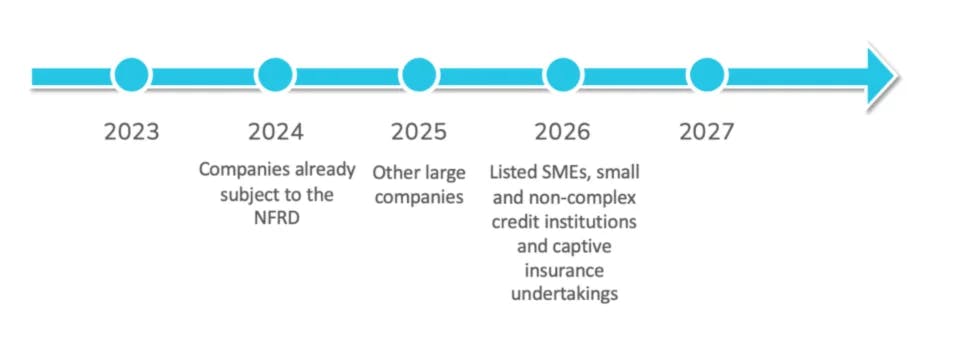

What to know about CSRD and ESRS reporting?
The European Union has come up with a new reporting directive on corporate sustainability reporting. The directive will come into force early next year and the EU Commission has now accepted the standards on which the reporting is based. Around one directive, there are a lot of acronyms and terms, and getting information is not always simple. So, what should companies know about these standards and who they apply to?
The EU Commission published the final versions of the European Sustainability Reporting Standards (ESRS) at the end of July. These 12 standardsdefine the elements that will be used by undertakings covered by the CSRD (Corporate Sustainability Reporting Directive) to report their sustainability information.
Starting with the timeline of the Directive, the first reporting obligation will apply to large undertakings, organizations in other words, already covered by the previous NFRD (Non-Financial Reporting Directive). These undertakings will report their 2024 data at the beginning of 2025. Next will be the other listed large undertakings, which are expected to report on sustainability in early 2026. Currently, the last stage includes listed small and medium-sized enterprises, whose first sustainability report is due to be published in early 2027.

How to prepare for ESRS standards?
The best way to prepare for the requirements is to start familiarizing yourself with the standards early on. Here are four tips for preparing for the standards:
- Find out which ESRS standards apply to your company. Each company must report at least the General Disclosures required by ESRS 2, and each company will assess, under the principle of double materiality, which other standards should be included in the sustainability reporting. So, for many companies, other parts of the suite of standards will also be required to report, but this gives companies some flexibility. However, the exclusion of standards from reporting needs to be thoroughly investigated and explained.
- It is important to start early when gathering information to meet the standards. For example, if climate change is deemed to be relevant for a company, this means that the company must calculate its greenhouse gas emissions according to the ESRS E1 standard.
- The data collection process and the content of the sustainability report should be planned in advance. For example, if a company reports data at the beginning of 2026, the data in the report will be from 2025. From an emissions calculation perspective, the scope of the baseline data collection and calculation process can be surprising when a company must calculate all Scope 1, 2 and 3 emissions related to its operations.
- In the future, emission data may also be requested from SMEs not covered by the CSRD and the availability of this information may be useful for competing in tenders. Companies covered by the CSRD will need to investigate their supply chain and include emissions from, for example, raw material purchases. This means that the demand for emissions data can also affect smaller companies, and while for many companies, sustainability and emissions accounting are already part of their operations, now is the latest time to look into these issues in more detail.
Let's take a closer look at the climate change standard ESRS E1 mentioned above, especially from the perspective of greenhouse gas emissions calculation. What remains the same and what changes does the new standard bring?

How will the ESRS E1 standard affect emissions accounting?
For the most part, the ESRS E1 requirements are in line with the GHG Protocol standards. If a company has already calculated emissions in accordance with the GHG Protocol standards, the situation is good for the company, as no major changes are expected. If the company has not yet calculated emissions and will be affected by the CSRD requirements, it is better to prepare sooner rather than later. Now there are a few things to bear in mind with the new sustainability reporting standards:
- Scope 3 emissions: in the future, scope 3 emissions will be an integral part of the calculation of greenhouse gas emissions for companies covered by the CSRD. However, there will be some extra time to prepare for this, as a company may still choose not to report these indirect scope 3 emissions in its first reporting year.
- Market-based and location-based calculation methods: The market-based method calculates emissions using emission factors provided by the energy producer, i.e. based on the energy supply contracts concluded by the company. The location-based method calculates emissions using the average electricity emission factors for a given area. These methods are related to the scope 2 emissions of the company, i.e. the company's purchased energy consumption has to be calculated using both methods and these results have to be reported separately. In addition, the total emissions of the company are reported using both methods.
- GHG emission intensity: the company must report total emissions divided by net revenue, resulting in an emission intensity figure.
- GHG emissions monitoring: many companies are already comparing their emissions with previous years and the base year. ESRS E1 also takes this into account by requiring companies to report emissions for the base year and the calculation year broken down by scope. At the same time, the company must also present interim and final targets for emission reductions.
- Associates, joint ventures, co-ownerships, etc.: The GHG Protocol standards have given different options on how to allocate emissions between companies in these situations. The new reporting guidelines require companies to include emissions from, for example joint ventures in their own emissions accounts if the company has operational control over another entity. In the past, it was possible to allocate emissions based on, for example, ownership, but this will no longer be possible.
- Offsetting emissions: if emissions are offset, this must be reported separately and cannot be counted directly towards the company's emissions. The data and emission factors used in the calculation and the calculation methodology must be reported in detail in accordance with CSRD requirements. Companies should also be careful with climate claims, as the EU is also preparing a Green Claims Directive, which aims to reduce the risk of greenwashing and clarify various climate and environmental claims, especially for consumers and investors.
The requirements of the new Corporate Sustainability Reporting Directive (CSRD) have already been outlined in our previous blog post, where we explained that the CSRD includes requirements for environmental, social and economic responsibility and replaces the previous NFRD. In addition to the ESRS E1 standard, other standards included in the ESRS package have been introduced in the previous blog post.
The OpenCO2.net platform's organization-specific calculators comply with the GHG Protocol standards and are suitable for ESRS E1 emissions calculation. If you would like to learn more about our calculation tools and our emission calculation consulting services, please contact us.
Do you want to hear more about our services?
Contact us via the form or directly to our expert, and we can figure out together which OpenCO2net calculator would work best for your organization.
Sari Siitonen
Founder, CEO
sari(a)openco2.net
+358 40 761 5221
